 By all accounts, about 10 million migrant workers have been stranded in different parts of the country after Prime Minister Narendra Modi announced a nation-wide lockdown on March 24.
By all accounts, about 10 million migrant workers have been stranded in different parts of the country after Prime Minister Narendra Modi announced a nation-wide lockdown on March 24.
A day after the Union Home Ministry allowed the inter-state movement of migrant workers, a train carrying about 1,000 labourers took off from Lingampally in Telangana for Hatia in Jharkhand on Friday morning. The home ministry had initially allowed the movement of these workers in buses. But several states had questioned the feasibility of the move and demanded that the railways run special trains to ferry the stranded migrants. The Centre has done well to accede to their request. The railways has outlined plans to run special Shramik Trains to move migrant workers, tourists, students, and pilgrims back to their homes. It has asked the state governments to make sure that the Centre’s COVID-19-related guidelines on the screening of inter-state travellers are scrupulously followed. It’s now up to these governments to draw up plans and protocols for this purpose. They must hold regular conversations with the railway authorities to ensure transparency in running the special trains.
By all accounts, about 10 million migrant workers have been stranded in different parts of the country after Prime Minister Narendra Modi announced a nation-wide lockdown on March 24. Having lived on charity in cramped shelters arranged by state governments, NGOs and some business outfits, these workers are yearning to go back to the familiarity and comfort of their villages. The prospect of a train back home is bound to kindle their hopes. But such situations are also rife with feelings of desperation and anxiety. This was evident in Mumbai, about three weeks ago, when distressed migrants swarmed the Bandra railway station, anticipating a relaxing of the lockdown. When their hope turned to disappointment, the hapless workers took to the streets. To prevent such a situation from recurring, the railways and the state governments must engage and inform the migrants while planning special trains. Decisions on who gets to be on the trains must be fair and must be seen to be so too. The state must keep all channels of communications open with those who might temporarily be left out.
The railways has said that the passengers on the Lingampally-Hatia train were screened and social distancing protocols followed during the journey. Given that several studies have shown that most coronavirus carriers are asymptomatic, the imperative of following such protocols on future journeys cannot be overstated. The state governments and railway officials should make sure that these operations are conducted without burdening the migrants but at the same time, care should be taken to ensure that the virus does not spread to the country’s rural areas. All this may pose logistical challenges for the railways and the state governments. It will require them to cooperate and coordinate on matters such as making lists of the travelling migrants, ensuring screening facilities for them, and arranging transport to, and from, the railway stations. This is an opportunity for these authorities to get the first steps towards the opening up right. For that reason, they will be closely watched.